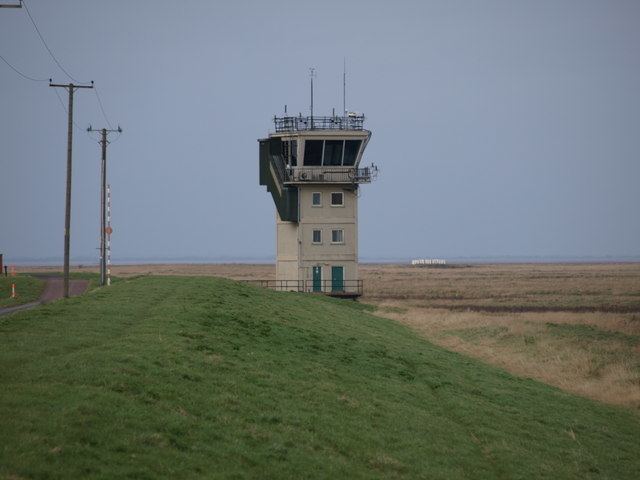Controlled by Royal Air Force Area 38.75 km² Year built 1926 | Elevation 5 m Phone +44 1406 550364 Owner Ministry of Defence | |
 | ||
Type RAF Air Weapons Training Range Operator Defence Infrastructure Organisation Open to
the public Yes (Public footpath only) Website DIO Holbeach Academic Weapons Range Built by The En-Tout-Cas Co. (Syston) Ltd., (Aviation Dept.) of Leicester Address Durham's Rd, Spalding PE12 9NJ, UK Hours Open today · 9AM–5PMWednesday9AM–5PMThursday9AM–5PMFriday9AM–12PMSaturdayClosedSundayClosedMonday9AM–5PMTuesday9AM–5PMSuggest an edit Similar Boston Police Station, RAF Lakenhe, RSPB Frampton Marsh, University of Lincoln - Holbeach, HMP North Sea Camp | ||
Forward air controllers with tornado typhoon jets at raf holbeach range
RAF Holbeach, now DIO Holbeach AWR is a Royal Air Force academic air weapons range (AWR) situated between Boston and King's Lynn near Gedney Drove End on The Wash, in Lincolnshire, eastern England. Most of the range, including the control tower and four observation towers (Quads) are in Gedney, but it does overlap with Holbeach to the west. On UK Civil Aviation Authority issued aeronautical charts the military Danger Area is found marked and identified by the code WRDA D207/II or the ICAO code EG D207 (Weapons Range Danger Area or United Kingdom Danger, 207, the danger altitude is usually up to twenty-three thousand feet AMSL).
Contents
- Forward air controllers with tornado typhoon jets at raf holbeach range
- A 10c thunderbolt iis at raf holbeach bombing range 11 08 2011
- History
- Emblem
- Facilities
- Strafing
- References
A 10c thunderbolt iis at raf holbeach bombing range 11 08 2011
History
The range opened in 1926 as an air gunnery range attached to and established by R.A.F. Practice Camp Sutton Bridge (later named RAF Sutton Bridge). Use of the range began on 27 September 1926, with biplanes firing and dropping bombs over the area formally known as "Holbeach Air Gunnery and Bombing Range", and colloquially simply as Holbeach Marsh Range.
During the late 1950s, when RAF Sutton Bridge was placed on a Care and Maintenance role, the coastal marshland air gunnery range was renamed to RAF Holbeach Bombing Range and it became later parented to RAF Marham as an Air Weapons Range (AWR) within RAF Strike Command. On 1 April 2006 control was transferred to the Ministry of Defence (Defence Estates East) and the range is now administered by Defence Training Estates (East) from their headquarters at West Tofts Camp near Thetford.
As of 2016 The Defence Infrastructure Organisation (DIO) are responsible for maintaining a safe place to operate in, the RAF are responsible for safe practice on the Range. The Range is now administered by the Range Training Safety Officer (TSO) who has an office at the Range. DIO contract in staff to assist in the day-to-day running of the Range.
Emblem
The station's badge features a vertical sword through a crown. The motto is Defend and Strike.
Facilities
Extending over an area of 3,875 hectares, which includes 3,100 hectares of intertidal mudflats and 775 hectares of salt marsh, the air weapons range provides facilities for RAF and NATO-allied aircraft to practice dropping bombs and firing their aircraft weapons, including pre-deployment training. Since 1993 this has included night bombing and helicopter operations. The range facilities are not only used by air force squadrons stationed in the United Kingdom but also fly over directly from airbases located throughout Europe. An assortment of range targets, 8 in total, include several retired merchant ships which have been beached on the sands of The Wash for this purpose. Observation towers parallel to the target line are manned and allow the fall of aircraft ordnance to be calculated for accuracy by means of triangulation. The range includes a helicopter landing pad near the main control tower and since 2010 a new range headquarters building. At the present time aircraft types such as the Tornado GR4, Eurofighter Typhoon, USAF F-15Es (from 48th Fighter Wing), USAF A-10 Thunderbolt, Hawk Trainer and AgustaWestland Apache AH1 helicopters can be seen operating on the range at various times of the day, including on occasions CV-22B Osprey (from 7th Special Operations Squadron), HH-60G Pave Hawk (from 56th Rescue Squadron), Chinook, Merlin and Puma HC helicopters. The range also hosts Forward Air Control (FAC) or Joint Terminal Attack Controller (JTAC) exercises.
Strafing
RAF Holbeach also has facilities for scoring strafing runs. The strafing targets are a number of three-metre square net with an orange bullseye made by weaving plastic strips through the chicken-wire net. The Strafe Scoring detects the X-Y position of the projectile from the acoustic signature of the supersonic shock wave. This result is sent by radio to the control tower, where it is displayed to the Air Traffic Controller for relaying to the pilot. The range also has semi-automatic bomb and rocket scoring systems.
